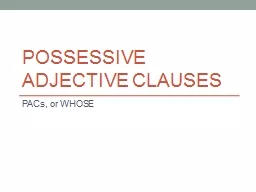

PACs or WHOSE REVIEW The relative pronouns you know already are Who Which That You also know the words Where When SAC Thats the lady who I kissed OAC I found the pencil which Id lost yesterday ID: 515372
Download Presentation The PPT/PDF document "Possessive adjective clauses" is the property of its rightful owner. Permission is granted to download and print the materials on this web site for personal, non-commercial use only, and to display it on your personal computer provided you do not modify the materials and that you retain all copyright notices contained in the materials. By downloading content from our website, you accept the terms of this agreement.
Slide1
Possessive adjective clauses
PACs, or WHOSESlide2
REVIEW
The relative pronouns you know already are:
Who
WhichThatYou also know the words:WhereWhen
SAC:
That’s the lady
who I kissed.
OAC:
I found the pencil
which I’d lost yesterday!
OPAC:
We’re looking for the lady
that you were talking to.Slide3
REVIEW
What are the possessive pronouns?
My
YourHisHer
Its
Their
OurSlide4
WHOSE
If we want to describe a noun by what it
has
, we use the relative pronoun WHOSE.
Describing something for what it
did
:
I found the lady
who punched me!
Describing something for what it
has
:
I found the lady
whose friends
are famous!Slide5
WHOSE
We can make
whose
the subject, object, or OP of the AC.
S + V
whose S
+ V + O
OR
S + V
whose O
+ S + V
OR
S + V
whose OP
+ S + V + prepositionSlide6
WHOSE
The structure can be confusing:
noun (whose + S + V)
The SUBJECT is NOT the noun that the AC it is next to!
noun (whose + O + S + V)
The
OBJECT
is
NOT
the noun that the AC is next to!
I found the lady
whose dog bit you!
The dog
did
the action!
I found the lady
whose dog you stole
!
The dog
received
the action!Slide7
WHOSE
Instead of the noun before the relative pronoun doing or receiving the action, the noun INSIDE THE AC takes its place!
I saw the
man who
you kicked.
I saw the man
whose dog
you kicked!
I saw the
lady who
kissed you!
I saw the lady
whose friend
kissed you!Slide8
WHOSE
I found the lady
who punched me!
I found the lady whose friends
are famous!
Describing something for what it
did
Describing something for what it
has
:
S
in AC
S
in ACSlide9
WHOSE
I know the man
who you talked to.
I know the man
whose car
you stole!
Describing something for what it
did
Describing something for what it
has
:
OP
in AC
S
in AC
O
in ACSlide10
PRACTICE:
On the next page, make simple sentences about the man.
Ex: The man is sitting.
I see the man.Then, describe him by his possessions. Remember – there MUST be a verb in the AC and the main clause!Ex: The man
whose dog
is
cute
is
sitting.Slide11
PRACTICE: Slide12
FINALLY:
In English, PACs can only describe an ANIMAL or HUMAN.
We avoid PACs for other things!
There’s a man
whose computers cost $50,000.
I have a desk
whose legs are made of metal.
X
I have a desk with legs made of metal.
This is a country
whose people are
strong
.
X
This is a country with
strong people.